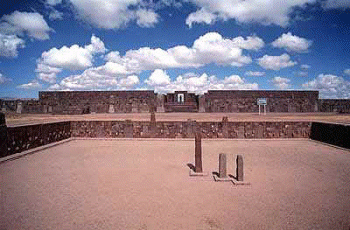
Tiahuanaco: 
Just 12 miles south of the southern-most tip of Lake Titicaca, lie the ruined remains of Tiahuanaco, the site of a technologically advanced culture, considered by some archaeologists to be the oldest ruins in the world. Although some scholars have attributed the buildings of Tiahuanaco to the Incas, it has now been established that the city was already in ruins when the first Incas arrived at Lake Titicaca.
In 1540 the Spanish chronicler, Pedro Cieza de Leon, visited the area and his description of the site compares very closely to what we see of the remains today. Tiahuanaco is located at an altitude of some 13,300 feet, which places it 800 feet above the present level of Lake Titicaca. Most archaeologists agree that Tiahuanaco was a flourishing port on the edge of the lake, which means that the water has receded almost 12 miles and has dropped about 800 feet since then. All agree that the lake is shrinking, mainly due to evaporation, since there are no rivers that flow into it.
The Tiahuanaco culture, is unique in its sculpture and style of stone construction. The figures depicted in the artwork, have a square-ish head, with a covering of some sort, rather like a helmet, square eyes and a rectangular shaped mouth. The stone works at the site consist of such structures as the Gateway of the Sun, a portal carved from a single block of stone and weighing some 15 tons, the stone steps of the Kalasasaya, each of which is a rectangular block of stone about 30 feet wide, the carved "idols,"each of which stand about 23 feet tall, and have typical Tiahuanaco features, and the enormous monolithic stone blocks, many of which appear to have been "cast" rather than carved.
Some of the remains are to be found at a depth of 6 feet beneath the soil. The mountain ranges which surround the area do permit sufficient runoff of water or wind erosion to have covered the ruins to this depth. This remains one of Tiahuanaco's greatest mysteries. One which has not been adequetly answered by archaeologists.
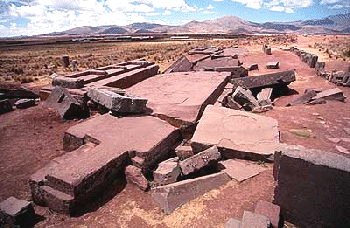
At an area called Puma Punku, which is about 1 mile away from the main ruins, the enormous stones have a bluish-gray color and give off a metallic ring when tapped. Many of these massive stone blocks have lain in the same position for thousands of years. Archaeologists have speculated that the stones were dressed at some time, but that the construction for which they were intended was never erected.
There are legends which have persisted over the generations that there are more stone structures beneath the waters of Lake Titicaca, Of the same design as found at Tiahuanaco and Puma Punku. Until recently there has been no proof of such structures. In November 1980, the Bolivian author and authority on pre-Columbian cultures, Hugo Boero Rojo, announced the discovery of some archaeological ruins beneath Lake Titicaca, about 15 to 20 meters below the surface, on the northeast edge of the lake. At a press conference he stated that "we can now say that the existence of pre-Columbian constructions under the waters of Lake Titicaca is no longer a mere supposition or science-fiction, but a real fact. Further, the remnants found show the existence of old civilizations that greatly antecede the Spanish colonization. We have found temples built of huge blocks of stone, with stone roads leading to unknown places and flights of steps whose bases were lost in the depths of the lake amid a thick vegetation of algae." Boero Rojo described these monumental ruins as being "of probable Tiahuanaco origin.'
The archaeologist Arthur Posnansky had concluded that, the Tiahuanaco culture began in the region at about 1600 BC and flourished until at least 1200 AD. His contemperary, Professor Hans Schindler-Bellamy, believed Tiahuanaco may have reached back to 12,000 years before the present era. What happened to this advanced ancient culture, however, has not yet been determined.
The discovery of ruins beneath the waters of Lake Titicaca may create more problems than it solves. If, over the past 3 or 4000 years Lake Titicaca has slowly receded, as is the case, then how do we explain the existence of the ruins of stone temples, stairways, and roads still under water? The only answer is that they were built before the lake materialized. We must, then, re-examine the ruins of Tiahuanaco, of which only 10 percent have been excavated. I have pointed out that dirt covers the ancient civilization to a depth of at least 6 feet. The only plausible explanation for this accumulation is of soil is water. A large amount of water had to have inundated the city, and when it receded left a layer of silt covering all the evidence of an advanced civilization, leaving only the largest statues and monoliths still exposed. It is logical to conclude, that Tiahuanaco was built before the lake was created. As the lake continues to recede, we should be find more evidence of the city's extent and its people. Scientists theorize that the area of Lake Titicaca was once at sea level, because of the profusion of fossilized marine life which can be found in the region. The area was then lifted up with the Andean upheaval and a basin was created, to form the lake. No one has suggested the marine life may have been deposited by sea waters which were in a flood stage.If a flourishing, advanced civilization existed many thousands of years ago and was reached by the flood waters, many problems would be solved, such as the existence of Tiahuanaco's ruins under 6 feet of earth at an elevation of 13,300 feet, the presence of stone structures still under the lake's waters and the existence of marine life at an impossible altitude.
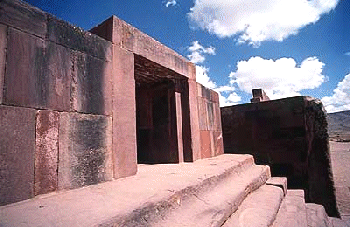
Peruvian legends, along with many others, relate the story of world-wide flood in the distant past. There is ample physical evidence of an universal inundation, with a world-wide deluge, described in more than a hundred flood-myths from around the world. Global doomsday prophecies are conspicuous in the Hopi Indian legends, the Finnish Kalevala epic, the Mayan Chilam Balam and Popol Vuh, and in the Aztec calendar, which predicts our present civilization will be destroyed by an earthquake. According to the Aztec prophecy, this will become the fifth doomsday, after the "death of the Jaguars", "the death of the Tempests", "the death of the Great Fire" and "the Great Deluge".
On the sides and very tops of the steep mountain peaks are agricultural terraces. These appear to be the oldest and now unused-portions of the terracing. Down the mountains are more and more terraces of recent origin. If there had been a world-wide deluge covering most of the earth's surface, leaving only mountain tops protruding, then the few remaining survivors, would plant their crops on these mountain terraces.As the flood waters receded the terracing began to creep down the mountain sides, with the ones nearest the bottom being the newest.
As Boero Rojo stated, "the discovery of structures beneath the waters of Lake Titicaca could pose entirely new theories on the disappearance of an entire civilization. The Tiahuanacans may have been victims of world-wide flood, their civilization all but wiped out, when the flood waters arrived. Because of the basin-like geography of the area the flood waters that became Lake Titicaca could not run off and have only gradually evaporated over thecenturies.
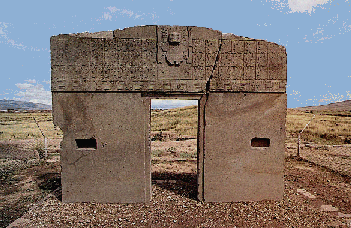
According to Professor Schindler-Bellamy, the large monolithic Gateway of the Sun was originally the centerpiece of the most important part of the Kalasasaya, the huge chief temple at Tiahuanaco. Its upper part is covered with an intricate sculpture in flat bas relief. This has been described as a "calendar" for almost as long as the gateway has been known to exist, the Sun Gate has also been called "the Calendar Gate". This calendar sculpture, though it depicts a "solar year," cannot be made to fit into the solar year as we know it at present. Thorough analysis of the "Sun Gate" sculpture revealed the fact that the calendar is not a mere list of days, it is actually, and more importantly, a unique record of astronomical, mathematical and scientific data, the quintessential knowledge of the Tiahuanacan culture. The "solar year" of the calendar, shown as symbols on the sculpture, indicates that the earth revolved more quickly than it does now, making the Tiahuanacan year only 290 days long, and divided into 12 "months" of 24 days each, plus two intermediary days. The enormous amount of information contained on the calendar is encoded in units of pictorial or abstract form. The different forms these units take on, give special, definite and very important additional meanings to them, making them take on multiple tasks. By means of this method, "any number" can be expressed without employing definite "numerals" whose meaning might be difficult to establish. It is only necessary to recognize the units, consider their forms and find their groupings, count them out, and render the result in our own numerical notations.
Some of the results seem to be so unbelievable that critics have rejected them as mere nonsense. But they are too well cross-referenced, in the greater system to be discarded, and as such, one has to accept them as correct. Anybody who rejects them, however, also accepts the onus of offering up a better explanation.
At the time Tiahuanaco flourished, the present moon was not yet the earth's sattelite, but still an independent exterior planet Luna. There was another satellite orbiting around our planet, rather closer, at 5.9 terrestrial radii, our present moon being at 60 radii. Because of its closeness it revolved around the earth more quickly than our planet rotated. It rose in the west and set in the east (like Mars' satellite Phobos), and so increased the number of solar eclipses, in one "solar year". It also caused an equal number of satellite eclipses, 37 in a "month", 447 in a "solar year". These numbers, 37 and 447, are shown in the sculpture, with many corroborating cross-references. Different symbols show when these solar eclipses, occurred: at sunrise, noon and sunset.
These are only a small sample of the exact astronomical information the calendar gives. It also gives the beginning of the year, the times of the equinoxes and solstices, the incidence of the two intercalary days, information on the obliquity of the eliptic (then about 16.5 degrees, now 23.5 degrees) and on Tiahuanaco's latitude (then about 10 degrees, now 16.27),and many other astronomical and geographical references, from which interesting and important data may be calculated. Tiahuanacan scientists certainly knew, that the earth was a globe which rotated on its axis, because they calculated exactly the times of eclipses not visible at Tiahuanaco but visible on the opposite side of the earth. A few more facts revealed in the calendar are both interesting and surprising, as indicated by an arrangement of "geometrical" elements, we can ascertain that the Tiahuanacans divided the circle into 264 degrees (rather than 360 degrees). Also, they determined the ratio of pi, the most important ratio between the circumference of the circle and its diameter, as being 22/7. They could calculate squares, trigonometry and the measuring of angles (30, 60and 90 degrees), they could calculate and indicate fractions, but do not seem to have had knownledge of the decimal system. They were able to draw straight lines and exact right angles, but no mathematical instruments have yet been found. We do not know what tools they used for working the hard andesite stone for the monuments, the methods employed for lifting and transporting great loads of stone, up to 300 tons, over great distances and even over stretches of water, from the quarries to the construction site. These will probably always be questions to which we have no answers.
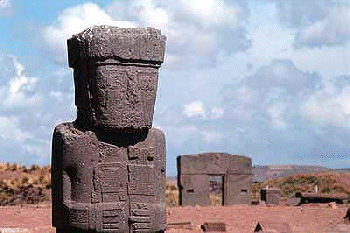
It is difficult to see how all the planning and designwork involved in producing a city the size of Tiahuanaco, could have been done without some form of writing, and with a notation other than the "unit" system depicted on the calendar stone. If they had, it must have written on perishable materials only, as there are no records left for us to decipher today.
Perhaps the most tantalizing mystery of all, is that the Tiahuanaco culture has no roots in that area. It did not grow from more humble beginnings. It seems to have appeared, practically fully formed, overnight. Only a few of the "older" monuments, as can be inferred from the "calendrical inscriptions" they bear, have ever been found. The different cultures discovered at considerable distances from Tiahuanaco proper, addressed as "Decadent Tiahuanaco" or "Coastal Tiahuanaco," are only very indirectly related to the culture revealed by the Calendar Gate. Tiahuanaco apparently remained for only a very short period at the peak of occupation, and perished suddenly, perhaps through a cataclysmic event such as a global flood. We have at present no means of determining when Tiahuanaco rose, or when its culture was obliterated, and naturally, the calendar itself can tell us nothing about that. It will certainly not have been in the historic past, but well back in the prehistoric. It must indeed have occurred before the present moon was captured as the earth's sattelite, more than 12,000 years ago.
The capture of the moon, imposed great stresses on the earth. The gravitational pull caused great floods and earthquakes until the moon settled into the stable orbit of today's distance. When the satellite approached within a few thousand miles, gravitational forces broke it up, according to the Roche formula, each planetoid or asteroid disintegrates when approaching the critical distance of 50 to 60,000 kms. The shattered fragments rained down on the earth, the oceans, released from the force of gravity, flowed back toward the continents, exposing tropical lands and submerging polar territories. This is a simple explanation of the "Horbiger theory", and, it seems to be the most logical one.
The approach of the "moon" caused a world-wide deluge, effecting changes of climate and provoking earthquakes which were accompanied by volcanic eruptions. The devastation left by the satellite after breaking into fragments caused a sudden drop in global temperatures of about 20 degrees. According to Horbiger, four moons have fallen on the earth, producing four Ice Ages, our present moon, the fifth one, will also be drawn in, and will cause the fifth cataclysm. (Remember the Aztec calendar prediction of destruction by earthquake!)
The theory of a falling moon has recently been substantiated by Dr. John O'Keefe, a scientist at the Goddard Laboratory for Astronomy in Maryland. Dr. O'Keefe claims that the fragments of the moon's collision, formed a ring around our planet that could have kept the sun's rays from penetrating the atmosphere, and so, causing a world-wide drop in temperature. After a while the fragments showered down on earth, breaking into objects known as tectites. These tectites O'Keefe believes were fragments of the fallen moon, thus adding weight to Horbiger's "World-Ice-Cosmology".
The records nevertheless show that an advanced culture made an attempt to establish its society at Tiahuanaco, wanting to replenish this region which had been devastated by floods. Such world-wide cataclysms appear in myths from all over the world, in the Egyptian Papyrus, "The sun set where it rose" or the tomb of Senmut, showing Orion-Sirius painted in reverse position, or in the Finnish Kalevala "the earth turned round like a potter's wheel", or the Popol Vuh, describing fire showering down from heaven, all of which indicate that our planet has suffered a world-wide catastrophe.